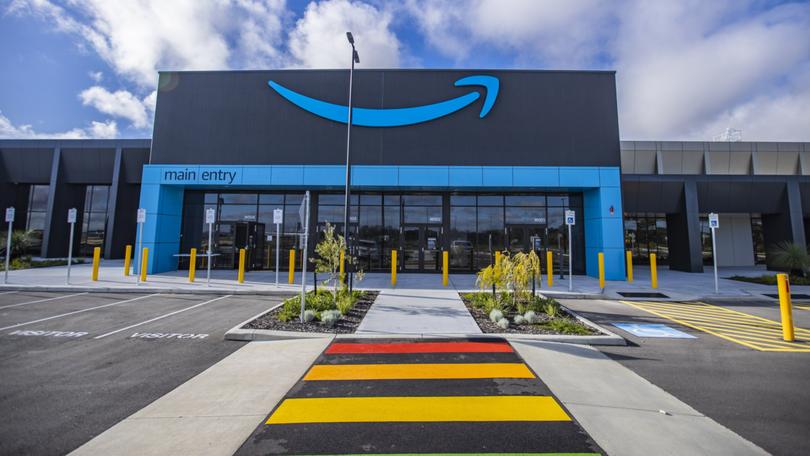Why Amazon’s huge growth in Australia has put Coles and Woolworths on notice

The enormous growth of Amazon in Australia has clearly worried the nation’s two biggest supermarkets — though that was nearly ignored by Senators leading a probe grocery prices.
In 2023 alone, by its own measure, Amazon increased its delivery capacity by almost 50 per cent and the year prior spent $5 billion in Australia. Aldi, for years seen as a more direct competitor to Coles and Woolworths, has spent $7b scaling up in Australia over 23 years.
The world’s sixth-most valuable publicly listed company, Amazon has a market capitalisation of $US1.885 trillion ($2.92t) — making it 75 times bigger than Woolworths ($38.8b) and 135 times the size of Coles ($21.5b).
Sign up to The Nightly's newsletters.
Get the first look at the digital newspaper, curated daily stories and breaking headlines delivered to your inbox.
By continuing you agree to our Terms and Privacy Policy.It’s made no bones about its expansion plans for Australia, expecting to grow the number of employees from 7000 to nearly 12,000 across all of its businesses. There are 4000 new jobs to be created at new sites in the next two years.
Now proudly stocking pantry staples — the sort of stuff that makes up about 60 to 70 per cent of a full-line supermarket — such as rice, pasta, toilet paper, soft drinks, oil and even Vegemite — the only segment on which it doesn’t compete is fresh fruit and vegetables, meat and poultry and chilled dairy.
But in the US and the UK, Amazon has (expensively) been trying for years to take on the supermarkets with bricks and mortar with a range of Amazon Fresh supermarkets and a $US13.7b buyout of Whole Foods Market, which has 500 outlets in the US. In both markets, it also delivers the products it doesn’t here.
Despite the dramatic scale-up in Australia — prompting speculation about how easily Amazon could scale up fresh produce supply chains and add chilled capacity at its six, soon to be 10, “fulfilment centres” across mainland Australia — the global monolith’s local operations have not made a profit. Sales in Australia were $3.1b last year but it posted a loss of $8.8 million.
Chief executive Andy Jassy earlier this month told shareholders Australia was an “emerging geography” for the company and was moving “toward profitability”. But in the same letter, he mulled about the prospect of its “very large and growing grocery business” growing.
“What if we used our same-day facilities to enable customers to easily add milk, eggs, or other perishable items to any Amazon order and get same day?” he said. “It might change how people think of splitting up their weekly grocery shopping, and make perishable shopping as convenient as non-perishable shopping already is.”

Amazon country manager Janet Menzies last year told The West Australian it was proud of forcing big rivals to shape up on delivery. A spokeswoman on Friday added the company was focused on delivering value for Australian shoppers.
“Recent research found that without the cost-efficiency and competitive effects of online retail channels, annual inflation would have been 0.7 percentage points higher at its peak in 2022,” she said. “These savings make a real difference to Australians trying to manage household budgets.”
Coles chief executive Leah Weckert pointed out given Amazon’s heavy reliance on automation and lack of physical stores, they had more efficiency in their supply base and they were “raising the bar” for delivery speed and ease for customers.
“With Amazon coming into the market and offering same-day delivery, and in some cases delivery within a couple of hours, that has reset that expectation with the customer,” she told the Senate this week, adding Coles was responding with ColesRapid, a 60- to 90-minute delivery service. Woolworths also offers MilkRun, which quotes an average 33-minute deliver time.
According to research by investment bank UBS, consumers who chose Woolworths as their primary online retailer for groceries fell from 43.3 per cent pre-pandemic to 40.8 per cent in the fourth quarter of last year, while for Coles it fell from 32.6 per cent to 30.4 per cent. IGA also fell, but Amazon jumped from 6.3 per cent to 9.8 per cent over the same period.
Despite both Woolies boss Brad Banducci and Ms Weckert citing Amazon as one way competition in the grocery sector was heating up, the pair were only asked a handful of questions when they faced the Senate about it on Tuesday.
“How many people can Amazon serve on a 24-hour basis? With their new warehousing system, they can get to 84 per cent of Australian households within 24 hours, and that’s the key metric,” Mr Banducci said.
“The key metric is not how many stores you have but how you can service your customers.”
Ms Weckert said Amazon was advantaged by “not having to drive the product all around the country to get it close to the customer”.
“Their operating model is to come in and set up the more traditional Amazon offering, which is your books and toys and electronics and the like, but then they will increasingly move into that grocery space, and they price very competitively because they do have a high willingness to come into a new geography and make low or negative returns for an extended period of time to build market share,” she said.
“Our experience of what we’ve observed overseas is that Amazon has become a significant player in the packaged grocery space.”
On top of Amazon, Costco has also grown enormously — one of its 15 Australian warehouses would do about four to five times the revenue of a regular supermarket, the bosses estimated. Another eight sites are earmarked for the American big-box warehouse.
While the supermarket bosses are always looking overseas at emerging trends, the potential for a game-changing approach to retail is growing by the month.
